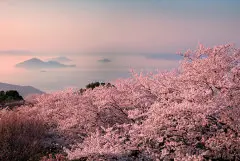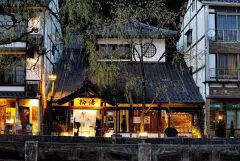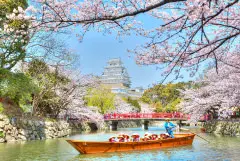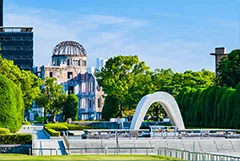Art & Culture
The Art of Shodoshima, Japan’s Soy Sauce Island in the Seto Inland Sea

Shodoshima is remarkably different from the mainland. When you arrive here, you immediately feel the pace of life gear down. This beautiful island is the antithesis of Japan’s pulsating metropolises, so don’t rush the experience. There are treasures galore to be found for art and design enthusiasts. For dedicated foodies, an incredible culinary adventure awaits.
Japanese Modern Art Installations of Tonosho Port
At Tonosho port on Shodoshima in the Seto Inland Sea, you will find several art installations within a few minutes’ walk of each other. I recommend visiting the Gift of the Sun by Choi Jeong Hwa, a golden wreath of olive leaves that welcomes you to the island. Again …, by Kim Kyoung-Min, reminded me of gentle surf breaking on a moonlit beach, and the ART no SHOW TERMINAL featured an exhibition and event space currently showing the Spike Dress by Junko Koshino. Viewing these art installations after you disembark from your ferry will help whet your appetite to discover the rest of what this Japanese art island has to offer.
A Secluded Island Retreat in the Highlands of Shodoshima
Speaking of appetite, as I arrived late in the afternoon on Shodoshima, I headed straight for the Cosmo Inn Yukien organic farm stay.
The delicious food is enough of a reason to spend a night at the Cosmo Inn Yukien organic farm stay. I have not enjoyed such a variety of salad greens in years! In the morning, we unearthed potatoes and collected organic salad leaves. So delicious! Around the farm, you’ll want to walk by the expansive olive groves overlooking the sea. I found the farm stay owner’s cat to be a constant source of entertainment as it tried to pounce on my hand as I harvested produce. It was such a joy to feel the warmth of the sunrise and hear the melody of early morning birdsong. You can also enjoy milking goats, shiitake mushroom picking, and tangerine picking here.
Artistic Treasure Hunt and Cycling Along Shodoshima’s Coastline
I thoroughly enjoy a drive along the coast, and the drive along the shoreline of Shodoshima doesn’t disappoint. When I first approached the Bollard of Love by Hisakazu Shimizu, a robust, oversized bollard for mooring ships, it reminded me of the waves leaping from the sea in a recent Studio Ghibli film. Next to a Japanese cinema theme park, across the road, walk southeast along the narrow road heading to a wonderful view of the ocean. Near the very end of the Tanoura Peninsula, this beach is a fantastic place to relax and have a picnic while watching the waves. From here, you can see the islands of Shikoku and Awajishima on the distant horizon.
Avid cyclists will have no problem with Shodoshima, and cycling is a great way to enjoy the treasure hunt for all the art installations on the island. The art installations should be the focal point of your tour of Shodoshima, and the olive trees will be your constant companions.
Just 6 km from The Bollard of Love, you will come to an equally compelling art installation, Star Anger by Kenji Yanobe. On a sunny day, Star Anger will shower you with sunlight from its thousands of tiny mirrors. This art installation sits on the site where Sakate Port’s lighthouse once stood and can be seen lit up each evening until 23:30. The dragon perched on top of the glittering sphere is considered the god of water — my favorite art installation on Shodoshima. Be sure to closely examine the mural on the adjacent port building to try to guess the underlying meaning of Star Anger.
Delicious Aromas of Olives and Soy Sauce Await on Shodoshima
As I continued to explore this Japanese art island, I noticed an incredible aroma in the town of Shodoshima. It is the heady, sweet, salty aroma of soy sauce! Nowhere in Shodoshima is this more apparent than when walking or riding along the narrow roads around Regent of Olives, by Hisakazu Shimizu. The area is a fusion of East meets West (soy sauce and olives), with narrow lanes perfect for cycling. The oversized olive with its pompadour hairstyle looks a bit like a rockabilly singer from the early 1950s! Regent of Olives feels like a lost world, a lovely spot to explore the narrow, winding lanes until your heart’s content. Keep your camera ready as you enjoy the traditional buildings, tiny temples, and olive groves. What contrast!
The Traditional Japanese Art of Making Soy Sauce
There are an incredible 20 soy sauce manufacturers on this island — that’s 25% of all the traditional soy sauce makers in Japan, making this a soy sauce Mecca! Yamaroku Shoyu, one of the local soy sauce makers, makes the sweetest soy sauce on the island. Natural yeast has been oozing out of Yamaroku’s massive cedar barrels for at least five generations. This is the result of the natural process of making soy sauce in the traditional method. Today, just 1% of the soy sauce produced in Japan is made in this way. The oldest of Yamaroku’s 84 barrels is 150 years old and still in use. These barrels take the concept of ‘well-seasoned’ to the next level!
The all-natural ingredients in their soy sauce include soybeans from Hokuriku, wheat from Hokkaido, sun-dried salt from Mexico, and on-site well water.
The final, and arguably most important ingredient, is the natural yeast which arrives in the breeze. The windows of Yamaroku’s Kura, the brewing facility, are opened when there is a dry wind. The soy sauce can be inoculated with natural yeasts to begin the fermentation process. Yamaroku’s soy sauce is made in the winter, fermented in the spring and summer, and then aged for 2 to 4 years to produce the intense umami flavors that pair so well with tuna sashimi and beef. Surprisingly, 99% of the soy sauce made in Japan only takes between 3 to 6 months from bean to bottle and is only fermented in stainless steel tanks. Yamaroku and the rest of Shodoshima’s soy sauce producers are ‘old school.’ Drop by Yamaroku for a tour and tasting!
The next time I get a chance to visit Shodoshima, I will make it an absolute culinary adventure. I plan to see as many soy sauce makers as possible to do comparative tastings. Where else can you get the freshest sashimi to dip into the best soy sauce? With its natural beauty, art, olives, and soy sauce, Shodoshima has not seen the last of me.
How To Get To Shodoshima?
Shodoshima is 60 to 90 minutes by ferry from Uno Port in Okayama Prefecture. The closest Shinkansen high-speed bullet train station, which connects Tokyo, Kyoto, Osaka, Hiroshima, and Fukuoka is JR Okayama Station. From JR Okayama Station, take the JR Uno Line to its terminus, JR Uno Station. The ferry terminal is across the road from the station.
How To Get To Shodoshima From Tokyo
There is a direct service between Tokyo and Okayama on the JR Tokaido-Sanyo line. From JR Okayama Station, take the JR Uno Line to its terminus, JR Uno Station. The ferry terminal is across the road from the station.
How To Get To Shodoshima From Kyoto
There is a direct train between Kyoto and Okayama on the JR Tokaido-Sanyo line. From JR Okayama Station, take the JR Uno Line to its terminus, JR Uno Station. The ferry terminal is across the road from the station.
How To Get To Shodoshima From Osaka
There is a direct service between Osaka and Okayama on the JR Tokaido-Sanyo line. From JR Okayama Station, take the JR Uno Line to its terminus, JR Uno Station. The ferry terminal is across the road from the station.
How To Get To Shodoshima From Kobe
There is a direct service between Kobe and Okayama on the JR Tokaido-Sanyo line. From JR Okayama Station, take the JR Uno Line to its terminus, JR Uno Station. The ferry terminal is across the road from the station.
Photographs and text by David Ellis
RELATED DESTINATION
Kagawa
This is an area with many islands, including Naoshima and Teshima, which are famous for art. It also is home to the tasteful Ritsurin Garden. Kagawa is also famous for its Sanuki udon, which is so famous it attracts tourists from throughout Japan. The prefecture is even sometimes referred to as “Udon Prefecture.” [Photo : “Red Pumpkin” ©Yayoi Kusama,2006 Naoshima Miyanoura Port Square | Photographer: Daisuke Aochi]










































